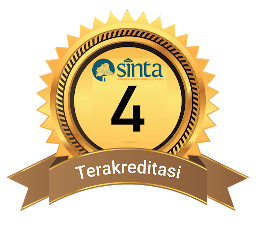Development of Student Worksheet (LKPD) Based on Ethnoscience to Improve Students Creative Thinking Skills
DOI:
10.29303/cep.v7i1.4583Published:
2024-05-31Issue:
Vol. 7 No. 1 (2024): Edisi Mei 2024Keywords:
Development, Student Worksheet, Ethnoscience, Creative Thinking, HydrocarbonsArticles
Downloads
How to Cite
Abstract
This research aimed to develop a students ethics science worksheet that is appropriate (valid, practical, and effective) for improving students’ critical thinking skills. This development research was conducted based on 4D models (define, design, develop, and disseminate). The validity level of student’s ethics science worksheet was validated by 3 (three) validators obtained a result V of 0,79 with valid categories. The practicality level of students’ ethics science worksheet obtained persentase of 88,5% with very pratical categories. The effectivenes level of students’ ethics science worksheet in improving students’ critical thinking skills is shown by the results n-gain analysis of 0,62 with a persentase of 0,62% in the moderate categories and effective enough. Furthermore, for each aspect of the ability to think creatively, scores are obtained for aspects fluency, eleboration, flexibility, and originality with an average N-gain are 0,67, 0,58, 0,63, and 0,55. Thus it can be concluded that, the students’ ethics science worksheet is appropriate to use to improve students’ creative thinking skills.
References
Andayani, Y., Purwoko, A. A., Jamaluddin, Makhrus, M., & Harjono, A. (2020). Identifikasi Pemahaman Guru Tentang Pengembangan Perangkat Pembelajaran IPA SMP dengan Pendekatan Etnosain. Jurnal PEPADU, 1(2), 229–234.
Damayanti, C., Rusilowati, A., & Linuwih, S. (2017). Pengembangan Model Pembelajaran IPA Terintegrasi Etnosains. Journal of Innovative Science Education, 6(1), 116–128.
Hake, R. R. (1999). Analyzing Change/Gain Scores. Indiana University.
Pawestri, E., & Zulfiati, H. M. (2020). Pengembangan Lembar Kerja Peserta Didik (Lkpd) Untuk Mengakomodasi Keberagaman Siswa Pada Pembelajaran Tematik Kelas Ii Di Sd Muhammadiyah Danunegaran. TRIHAYU: Jurnal Pendidikan Ke-SD-An, 6(3), 903–913. https://doi.org/10.30738/trihayu.v6i3.8151
Rachmawati, D., Suhery, T., & Anom, K. (2017). Pengembangan Bahan Ajar Kimia Dasar Berbasis Stem Problem Based Learning Pada Materi Termodinamika Untuk Mahasiswa Program Studi Pendidikan. Prosiding Seminar Nasional Pendidikan IPA 2017, 239–248.
Riduwan. (2007). Rumus dan Data dalam Aplikasi Statistika. Alfabeta Rinika Cipta.
Saputra, B. A., Kuntjoro, S., & Ambarwati, R. (2016). Validitas Lembar Kegiatan Berorientasi Pengamatan Burung untuk Meningkatkan Hasil Belajar Materi Aves Kelas X. Jurnal Berkala Ilmiah Pendidikan Biologi, 5(1), 32–36.
Sudarmin. (2018). Pendidikankarakter, Etnosains, dan Kearifan Lokal. FMIPA Universitas Negeri Semarang.
Sumarni, W. (2018). Etnosains dalam Pembelajaran Kimia: Prinsip, Pengembangan dan Implementasinya. Unnes Pres.
Ubaidillah, M. (2016). Pengembangan LKPD Fisika Berbasis Problem Solving untuk Meningkatkan Keterampilan Proses Sains dan Keterampilan Berpikir Tingkat Tinggi. Jurnal EduFisika, 01(02), 9–20.
Untari, S., Suparlan, K., & Wahyu, N. (2008). Pengembangan bahan ajar dan LKS mata pelajaran PKn dengan pendekatan deep dialoque/critical thingking untuk meningkatkan kemampuan berdialog dan berpikir kritis siswa SMA di Jawa Timur. Jurnal Penelitian Kependidikan, 18(1), 154–177.
Wasis. (2016). Kemampuan Sains Siswa Indonesia dalam Studi TIMSS. Workshop TIMSS FMIPA Unesa, 1–7.
Widyaningrum, R., & Prihastari, E. B. (2021). Integrasi Kearifan Lokal Pada Pembelajaran di SD Melalui Etnomatematika dan Etnosains (Ethnomathscience). Dinamisia : Jurnal Pengabdian Kepada Masyarakat, 5(2), 335–341. https://doi.org/10.31849/dinamisia.v5i2.5243
Author Biographies
Indah Permatasari Indah, Program Studi Pendidikan Kimia, Universitas Mataram. Jalan Majapahit No. 62 Mataram, NTB 83112
Aliefman Hakim, Program Studi Pendidikan Kimia, Universitas Mataram. Mataram, Indonesia
Muntari Muntari, Program Studi Pendidikan Kimia, Universitas Mataram. Mataram, Indonesia
Burhanuddin Burhanuddin, Program Studi Pendidikan Kimia, Universitas Mataram. Mataram, Indonesia
License
Copyright (c) 2024 Indah Permatasari Indah, Aliefman Hakim, Muntari Muntari, Burhanuddin Burhanuddin

This work is licensed under a Creative Commons Attribution-ShareAlike 4.0 International License.
Authors who publish with Chemistry Education Practice agree to the following terms:
- Authors retain copyright and grant the journal right of first publication with the work simultaneously licensed under a Creative Commons Attribution License 4.0 International License (CC-BY-SA License). This license allows authors to use all articles, data sets, graphics, and appendices in data mining applications, search engines, web sites, blogs, and other platforms by providing an appropriate reference. The journal allows the author(s) to hold the copyright without restrictions and will retain publishing rights without restrictions.
- Authors are able to enter into separate, additional contractual arrangements for the non-exclusive distribution of the journal's published version of the work (e.g., post it to an institutional repository or publish it in a book), with an acknowledgement of its initial publication in Chemistry Education Practice.
- Authors are permitted and encouraged to post their work online (e.g., in institutional repositories or on their website) prior to and during the submission process, as it can lead to productive exchanges, as well as earlier and greater citation of published work (See The Effect of Open Access).






